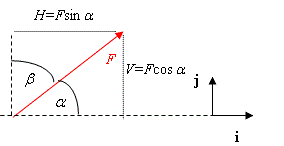Solution 4.5c
From Mechanics
(Difference between revisions)
Ian (Talk | contribs)
(New page: Image:teori4.gif Using <math>{{F}^{2}}={{H}^{2}}+{{V}^{2}}</math> and <math>\tan \alpha =\frac{V}{H} </math> Here <math>V=8\ \text{N}</math> and <math>H=-2\ \text{N}</math>....)
Next diff →
Current revision
Using \displaystyle {{F}^{2}}={{H}^{2}}+{{V}^{2}}
and
\displaystyle \tan \alpha =\frac{V}{H}
Here
\displaystyle V=8\ \text{N} and \displaystyle H=-2\ \text{N}.
Substituting the given values
giving
Also
\displaystyle \tan \alpha =\frac{8}{-2}=-4
giving
\displaystyle \alpha =-76\textrm{.}0{}^\circ
However the force is in the second quadrant so this angle is not correct.
Another possible angle which gives the same tan is
\displaystyle \alpha =180-76\textrm{.}0=104\textrm{.}0{}^\circ
This is in the second quadrant and thus is the correct answer.

